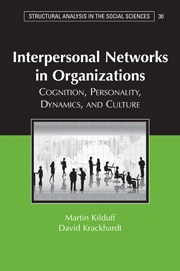Book contents
- Frontmatter
- Contents
- Acknowledgments
- 1 Introduction
- I Perceiving Networks
- II The Psychology of Network Differences
- 6 Social Structure and Decision Making in an MBA Cohort
- 7 The Social Networks of Low and High Self-Monitors
- 8 Centrality in the Emotion Helping Network: An Interactionist Approach
- III Network Dynamics and Organizational Culture
- References
- Index
8 - Centrality in the Emotion Helping Network: An Interactionist Approach
Published online by Cambridge University Press: 24 May 2010
- Frontmatter
- Contents
- Acknowledgments
- 1 Introduction
- I Perceiving Networks
- II The Psychology of Network Differences
- 6 Social Structure and Decision Making in an MBA Cohort
- 7 The Social Networks of Low and High Self-Monitors
- 8 Centrality in the Emotion Helping Network: An Interactionist Approach
- III Network Dynamics and Organizational Culture
- References
- Index
Summary
An organization can be considered a socio-emotional system in which energy must be continually expended in order to keep the system on course (cf. Katz and Kahn, 1966). Among the many threats to system functioning are negative emotions. The workplace is a site where people often experience negative emotions associated with stress, anxiety, tension, and emotional pain (Basch and Fisher, 2000). Two classic experiments (Latané and Arrowood, 1963; Schachter, Willerman, Hyman, and Festinger, 1961) established that workers involved in all but the most routinized tasks who are subject to negative emotions tend to suffer decrements in the quality and quantity of their production. Further, these negative emotions correlate with individuals' negative work-related attitudes (Weiss and Cropanzano, 1996) and health problems (Frost, 2003: 3), and can prove contagious (Hatfield, Cacioppo, and Rapson, 1994) with deleterious effects for other employees' levels of cooperation and performance (Barsade, 2002). We know that some people become central actors in dealing with the negative emotions of colleagues (Frost, 2003; Frost and Robinson, 1999), but there is still little understanding of who these unusual people are. In this chapter, we spotlight the emotion helping network and its central players from a personality interaction perspective.
Information
- Type
- Chapter
- Information
- Interpersonal Networks in OrganizationsCognition, Personality, Dynamics, and Culture, pp. 157 - 178Publisher: Cambridge University PressPrint publication year: 2008
